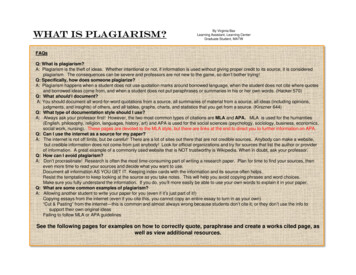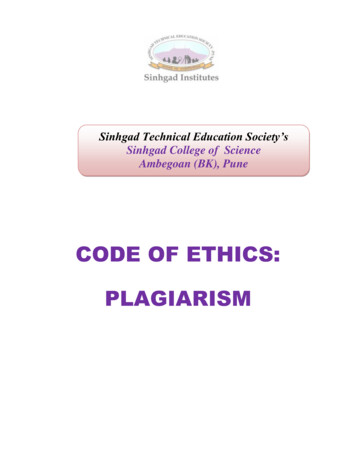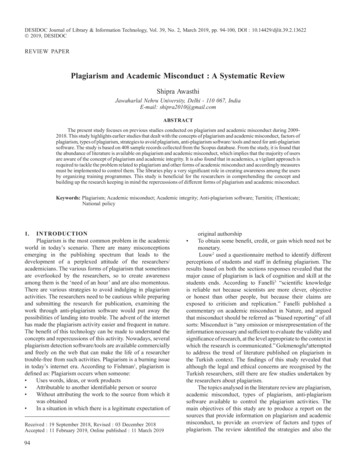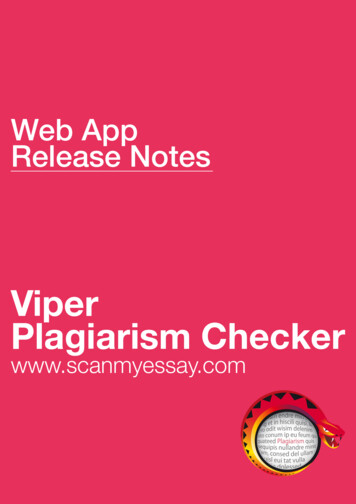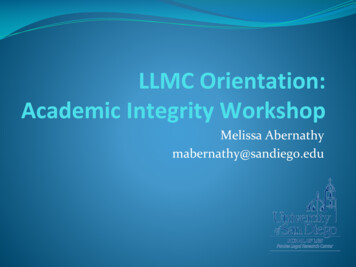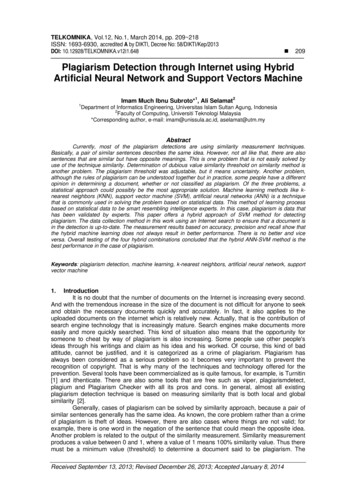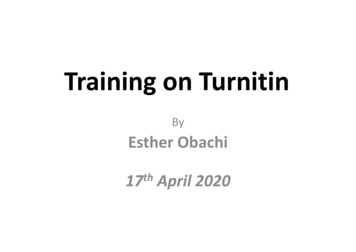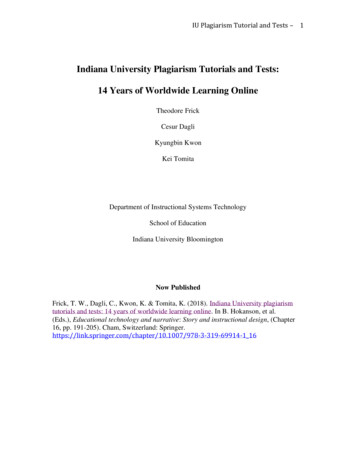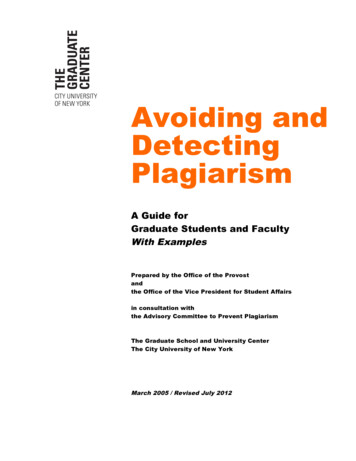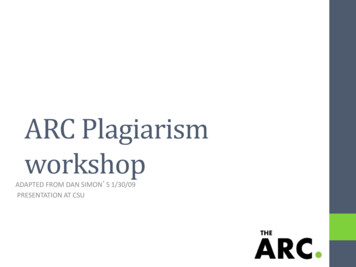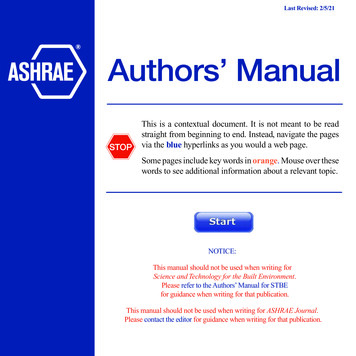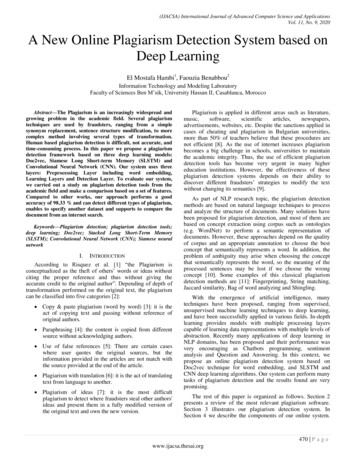
Transcription
(IJACSA) International Journal of Advanced Computer Science and ApplicationsVol. 11, No. 9, 2020A New Online Plagiarism Detection System based onDeep LearningEl Mostafa Hambi1, Faouzia Benabbou2Information Technology and Modeling LaboratoryFaculty of Sciences Ben M’sik, University Hassan II, Casablanca, MoroccoAbstract—The Plagiarism is an increasingly widespread andgrowing problem in the academic field. Several plagiarismtechniques are used by fraudsters, ranging from a simplesynonym replacement, sentence structure modification, to morecomplex method involving several types of transformation.Human based plagiarism detection is difficult, not accurate, andtime-consuming process. In this paper we propose a plagiarismdetection framework based on three deep learning models:Doc2vec, Siamese Long Short-term Memory (SLSTM) andConvolutional Neural Network (CNN). Our system uses threelayers: Preprocessing Layer including word embedding,Learning Layers and Detection Layer. To evaluate our system,we carried out a study on plagiarism detection tools from theacademic field and make a comparison based on a set of features.Compared to other works, our approach performs a goodaccuracy of 98.33 % and can detect different types of plagiarism,enables to specify another dataset and supports to compare thedocument from an internet search.Keywords—Plagiarism detection; plagiarism detection tools;deep learning; Doc2vec; Stacked Long Short-Term Memory(SLSTM); Convolutional Neural Network (CNN); Siamese neuralnetworkI.INTRODUCTIONAccording to Risquez et al. [1] “the Plagiarism isconceptualized as the theft of others’ words or ideas withoutciting the proper reference and thus without giving theaccurate credit to the original author”. Depending of depth oftransformation performed on the original text, the plagiarismcan be classified into five categories [2]: Copy & paste plagiarism (word by word) [3]: it is theact of copying text and passing without reference oforiginal authors. Paraphrasing [4]: the content is copied from differentsource without acknowledging authors. Use of false references [5]: There are certain caseswhere user quotes the original sources, but theinformation provided in the articles are not match withthe source provided at the end of the article. Plagiarism with translation [6]: it is the act of translatingtext from language to another. Plagiarism of ideas [7]: it is the most difficultplagiarism to detect where fraudsters steal other authors'ideas and present them in a fully modified version ofthe original text and own the new version.Plagiarism is applied in different areas such as apers,advertisements, websites, etc. Despite the sanctions applied incases of cheating and plagiarism in Bulgarian universities,more than 50% of teachers believe that these procedures arenot efficient [8]. As the use of internet increases plagiarismbecomes a big challenge in schools, universities to maintainthe academic integrity. Thus, the use of efficient plagiarismdetection tools has become very urgent in many highereducation institutions. However, the effectiveness of theseplagiarism detection systems depends on their ability todiscover different fraudsters’ strategies to modify the textwithout changing its semantics [9].As part of NLP research topic, the plagiarism detectionmethods are based on natural language techniques to processand analyze the structure of documents. Many solutions havebeen proposed for plagiarism detection, and most of them arebased on concept extraction using corpus such as ontologies(e.g. WordNet) to perform a semantic representation ofdocuments. However, these approaches depend on the qualityof corpus and an appropriate annotation to choose the bestconcept that semantically represents a word. In addition, theproblem of ambiguity may arise when choosing the conceptthat semantically represents the word, so the meaning of theprocessed sentences may be lost if we choose the wrongconcept [10]. Some examples of this classical plagiarismdetection methods are [11]: Fingerprinting, String matching,Jaccard similarity, Bag of word analyzing and Shingling.With the emergence of artificial intelligence, manytechniques have been proposed, ranging from supervised,unsupervised machine learning techniques to deep learning,and have been successfully applied in various fields. In-depthlearning provides models with multiple processing layerscapable of learning data representations with multiple levels ofabstraction. Recently many applications of deep learning inNLP domains, has been proposed and their performance wasvery encouraging as Chatbots programming, sentimentanalysis and Question and Answering. In this context, wepropose an online plagiarism detection system based onDoc2vec technique for word embedding, and SLSTM andCNN deep learning algorithms. Our system can perform manytasks of plagiarism detection and the results found are verypromising.The rest of this paper is organized as follows. Section 2presents a review of the most relevant plagiarism software.Section 3 illustrates our plagiarism detection system. InSection 4 we describe the components of our online system.470 P a g ewww.ijacsa.thesai.org
(IJACSA) International Journal of Advanced Computer Science and ApplicationsVol. 11, No. 9, 2020Section 5 draws some interpretations about the current state ofexisting discovery tools and compare them with our system. Inthe section 6, we finish by a global conclusion.II. PLAGIARISM TOOLS REVIEWA. Software DescriptionIn the context of academic plagiarism, few tools areproposed, and this section is devoted to describing the mostrecognized in the scientific community and in differentuniversities. In our latest state of the art we focused on theproposed systems for plagiarism detection based on deeplearning, unfortunately we did not find any implementation ofthese systems. Asim M. El Tahir Ali et al. have proposed aninteresting comparative study from five plagiarism detectiontools [13]: PlagAware, The PlagScan, CheckForPlagiarism.net, iThenticate and PlagiarismDetection.org.Inspired by this research, we conducted an overview of the topplagiarism detection tools based on some important criteriathat a good system would have. Firstly, we used thecomparison parameters in [13] as: Add a new database is the ability to add a new databasein comparison and plagiarism detection. Add a new corpus is the ability to add a new corpus forlearning to detect other types of plagiarism. Internet Checking is the ability to use internet results inplagiarism detection. Academical Checking is used to check the researchpublications and compare them to already publishedpapers. Multiple document comparison is the capacity ofsoftware to support multiple document comparison. Multiple language support is the ability to supportmultiple language in document analysis. Sentence Structure/synonymy show that softwaredetection is capable to make sentence structure andsynonymy analysis. In our study, we include other parameters to evaluatethe relevance of the plagiarism detection tools: Types of plagiarism to detect is a feature which allowsthe selection of the type of plagiarism to be detected. Machine learning means a machine learning model usedin the approach. Similarity based means if the software is based onmatching techniques and similarity measurement. Free license or not. Size limitedness describes if the size of the document islimited (e.g. some tools limit the size document to 1000words). Document file is the file format to be analyzed (e.g. txt,pdf, docx, etc.). Classical methods use a corpus to extract the concepts,but recent researches rely on word embeddingstechniques as Word2Vec, GloVe, BERT, to preservethe semantic and the syntactic context of the text. Type of plagiarism detected presents whether if thesoftware displays the types of plagiarism encounteredor not and gives the rate each type checked. Reports generation describes if the software exports theresults as a report.1) The PlagAware tool: It is an online tool [12] that uses aclassic search engine to detect plagiarism and offers severalreports helping the user to decide if the analyzed text isplagiarized or not. It is possible to add new database, to checkdocuments from the internet results, and to compare multipledocuments. Verifying sentence structure analysis andsynonymy replacement is not supported. The languagessupported are German, English and Japanese. It is used inuniversities to check the originality of the works to bepublished. PlagAware performs a complete scan of thedocument, and each sentence is analyzed to subsequentlydetect whether it contains plagiarism or not.2) The PlagScan tool: It is an online tool used foracademic plagiarism detection. This tool uses a local databasethat include millions of documents and includes the results ofthe internet search for making comparison. It supports addinga new database over the internet. It detects several types ofplagiarism such as: copy and paste or words switching [14].PlagScan supports the UTF-8 encoding languages and allLatin or Arabic languages. It is used in universities to checkthe originality of the works to be published. Sentence structureanalysis and synonymy replacement are not supported. Thistool uses a plagiarism detection algorithm that contains threeconsecutive word matches to subsequently detect plagiarismmethods which use the replacement the words by theirsynonyms. In addition, they apply matching algorithms todetect documents similarity.3) The CheckForPlagiarism.net tool: It is a tool fordetecting academic plagiarism developed by a professionalacademic team. It can detect several types of plagiarism. Ituses its own database that include millions of documents fromseveral databases with different domains. It performs aninternet Checking, Sentence structure analysis and synonymyreplacement is detected, and it is possible to compare multipledocuments. CheckForPlagiarism.net checks several types ofdocuments, including, newspapers, PDFs, magazines,journals, books, articles etc. It supports several languages:Spanish languages, Portuguese, German, English, Korean,French, Italian, Arabic and Chinese languages. Each documentis assigned by a fingerprint and used in document comparison[15].4) The iThenticate tool: iThenticate is an online academicplagiarism detection tool for researchers, publishers andauthors [16]. It possible in iThenticate to add a new databaseor use Internet for comparison and in addition it uses its own471 P a g ewww.ijacsa.thesai.org
(IJACSA) International Journal of Advanced Computer Science and ApplicationsVol. 11, No. 9, 2020database that contains several documents like books,newspapers and articles. Sentence structure analysis andsynonymy replacement checking is not supported byiThenticate but it is possible to compare multiple documents.It supports more than 30 languages likes English, Russian,Arabic, etc. Many online scientific journals use it forsubmitted papers checking. iThenticate performs a matchingadvanced technics in similarity analysis highlight materialwithin a manuscript that matches documents found in theiThenticate database algorithm to check the contents of adocument against an extensive database of published scholarlywriting [16].5) The PlagiarismDetection.org tool: This is an onlinetool that is mostly used by teachers and students [17]. It usedits own database that contains millions of documents, but it ispossible to add a new database or use internet Checking.Sentence structure analysis and synonymy replacementchecking is not supported neither multiple documentcomparison. It supports all languages using Latin characters.the technique is based on the n-gram method.6) The Urkund tool: URKUND is a web plagiarismprevention system. Today, a vast majority of universitiesaround the world use Urkund to effectively and detectTABLE I.FeaturesAdd newdatabaseAdd a corpusfor cture/synonymyTypes ofplagiarismMachineLearningFree LicenseSimilaritybasedSizelimitednessAll type offilesClassicalmethodType ofplagiarismdetectedReportsgenerationplagiarism. This system allows to compare the content of adocument with several other resources from different sources(Internet, database, internal documents, etc.). Documentformats accepted is doc, docx, pdf, etc. Urkund ismultilingual, detects plagiarism by paraphrasing andreplacements by synonyms, and returns the rate of similaritywith the other documents [ 21].7) The Turnitin tool: The Turnitin Plagiarism DetectionSystem allows users to check their documents and comparethem with web content and other documents that have alreadybeen downloaded by institutions as well as with certainjournals [22]. For each submission, a report is producedidentifying the sources of its similarities as well as thepercentage of correspondence with the submitted document.Turnitin uses a matching algorithm to find strings of wordswithin assignments that are identical to those within itsrepository.B. Comparison and AnalysisIn this section we propose a qualitative comparison ofplagiarism software detection. We focus on the features andproperties of the tools rather than their performance in the firstinstance. Based on the comparison parameters cited above theresults are reported in Table I.COMPARISON OF THE PLAGIARISM DETECTION m.netPlagiarismdetecting.orgURKUNDTurnitinxxxxx xxxxxxx xx x xxxxxxxx xx xx xx x xxx xx x xxxxxxx 472 P a g ewww.ijacsa.thesai.org
(IJACSA) International Journal of Advanced Computer Science and ApplicationsVol. 11, No. 9, 2020From Table I, we can see that all studied plagiarismdetection tools can perform Internet Checking to verify ifthere is any similarity with any resources on internet. Also, thedocument analyzed can be written in Multilanguage. Thesesystems are almost used in the Academical context to checkstudent reports, thesis, or research papers. Multiple documentscomparison is also provided by these tools. But as we see,most of them does not a have the feature of adding a newcorpus. This new feature enables adding a corpus to be used asthe basic dataset for the plagiarism detection step. It is anopportunity to use more corpus for improving the learningphase. The new corpus contains a source document, suspiciousdocuments and the type of plagiarism. As we can see inTable I, none of the analyzed tools specify the type ofplagiarism that has been detected from sources, nor give theuser the possibility to specify the type of plagiarism he wantsto be detected. Based on this comparison and to benefit fromour previous work [18], we propose an implementation withnew features to deal with a plagiarism in textual documents. Inthe next section, we describe the background of the approachand its components and the services that our framework canprovide.III. GENERAL FRAMEWORK OF OUR APPROACHThe proposed plagiarism detection tool is based on ourprevious research validated with PAN Dataset where data arelabeled with the types of plagiarism [20]. Fig. 1 represents aglobal architecture of our framework which is based on twoDeep learning architectures Siamese Long Short-TermMemory (SLSTM) and Convolutional Neural Networks(CNN).the approach. The goal is the classification of thedocument as plagiarized or not with the type ofplagiarism detected in it if yes.IV. DEEP LEARNING PLAGIARISM DETECTION SYSTEMIn this section we will present the proposed plagiarismdetection framework by illustrating the technical architectureand its different layers. Fig. 2 shows an overview of theproposed system. The system is composed by the followingsix layers: Front-end Layer, http layer, Controller Layer,preprocessing layer, Learning layer and Detection Layer. Herebellow, we present the description of each layer and itsimplementation.A. Front End Layer/ Http Layer/ Controller LayerThe Front end is a platform for building mobile anddesktop web applications that communicate with the http layerwhich offers web services to consume. The flask packageprovides some classes to build a Service layer and exposes anAPI that interacts with the model. The first idea is to removeall logic of the routes and model of the Flask application andput it in the service layer. The second goal is to provide acommon API that can be used to manipulate a modelregardless of its storage backend. The controller layerconcerns a middleware between the flask layer and the otherlayers of our system.B. Preprocessing LayerAt first, the corpus is preprocessed as shown in Fig. 3. Forach document we realize the cleaning, segmentation andstemming phases [18]. Then the output is given as input to thedoc2vec word embedding model layer.Fig. 1. Global Architecture.The approach based mainly on three steps as describedbelow: Context representation of documents: The corpusconsists of a set of source documents and a set ofsuspicious documents plagiarized from each sourceusing a specific kind of plagiarism. Both of sources andthe plagiarized document are transformed with doc2veca list of sentences vectors to be used as input to theSLSTM model.Fig. 2. The Distribution of Application Layers. SLSTM Learning phase 1: The Siamese LSTM isused to learn the different kind of plagiarism in dataset. CNN Learning phase 2: The output of the first stage isa SLSTM representation of documents. To consolidateour approach, we used CNN deep learning model todetect the types of plagiarism learned in the first part ofFig. 3. Data Preprocessing and Vectorization.473 P a g ewww.ijacsa.thesai.org
(IJACSA) International Journal of Advanced Computer Science and ApplicationsVol. 11, No. 9, 2020Then we launch the training phase to generate a doc2vecmodel which we will used later to transform each sentence ofa document to a vector. We worked with the re framework tobuild a regular expression that removes numbers, nltk tosegment a document by sentence, PorterStemmer to apply thesteaming principle that makes a word in the initial form andgensim to start training the doc2vec model.C. Learning LayerIn this layer, we applied twice the learning process asshown in Fig. 4. In the first step, we used SLSTM algorithmfor learning from the output of doc2vec and the output isgiven to CNN Model to learn again to build our efficientlearning model. At the end of this phase we restore theSLSTM model which will be used to test whether a pair ofdocuments are similar or not and we also get the SLSTMrepresentation. In this step we used the keras tensorflow.To carry out the classification of documents and add thetypes of plagiarism that have been detected, we used the kerastensorflow to build our CNN model. Hence, the outputs of theSLSTM model are used in the second learning phase whichconsists of classifying the types of plagiarism already learnedin the first part.D. Detection LayerFor document classification task (whether is plagiarized ornot), the users can make choice to use a new corpus, internetsearch results or a new corpus for comparison. The corpuscontains a list of sources documents that will be used inlearning step or to search for similarity with the text to beverified. The second option uses python Google package toget the link of the first n search results and compare the textanalyzed with the contents of these links. More details will begiven in the next subsections.1) Add a new corpus: To add a new corpus, we respect theprocess in Fig. 5. Firstly, the user adds the pairs file, whci is atext file that contains several lines and each line represents atype of plagiarism. Secondly, the user uploads the corpuscontaining the source and plagiarized document mentioned inthe pair document above.Fig. 5. Add New Corpus.Finally, the user defines the types and numbers ofplagiarism cases. But the number of plagiarism types enteredmust corresponding to the number of lines existing in the pairfile. After adding a new corpus, we can launch the trainingphase which follows the process in Fig. 6.2) Add a new corpus for comparison: Our framework canalso compare a document to a special corpus containing a setof desired source documents to compare with. We must firstadd corpus which will be the basis of comparison, and thesystem will compare the document to each document incorpus to detect a kind of plagiarism. Fig. 7 presents theprocess of this task. The comparison is carried out by usingthe following steps: Select corpus trained and corpus of comparison. Segment the analyzed document to a list of paragraphs. Retrieve a list of paragraphs for each document incorpus of comparison. Using our deep learning system, we compare eachparagraph of the analyzed document with all theparagraphs returned via the corpus of document.Fig. 4. Learning with SLSTM Model.Fig. 6. Launch Training.474 P a g ewww.ijacsa.thesai.org
(IJACSA) International Journal of Advanced Computer Science and ApplicationsVol. 11, No. 9, 2020A. Add New CorpusFor this task we proposed the following IHM in Fig. 9:Fig. 7. Plagiarism Detection from Corpus Process.3) Using google research engine: Our system can alsodetect the plagiarism in documents using google search resultas illustrate in the following Fig. 8.Fig. 9. Add New Corpus.B. Training a New CorpusTo do that, we must fill some information about corpus,doc2vec training, SLSTM training and finally CNN training.The data requested are used to develop the accuracy rate ofour training. For this phase we proposed the following IHM inthe Fig. 10.Fig. 8. Check Plagiarism from Internet.The plagiarism detection consists of the following steps: Segment the analyzed document to a list of paragraphsand the list of sentences. Use the sentences in this paragraph to retrieve thevarious links which contain the suspected texts. Retrieve a list of paragraphs for each link found. Using our deep learning model to compare eachparagraph of the analyzed document with all theparagraphs returned via the Google searches.More precisely we assume that the document contains Nparagraphs, if for example the first paragraph contains Ssentences, so we launch S internet search to retrieve S x Nresult then we assume once again that each result will offer usP paragraphs which are considered as suspected initials. So,the first paragraph of the analysis document is compared withN x S x P paragraph.V. EXPERIMENTSIn this section, we present different possibilities that oursystem provides in terms of plagiarism detection. We canproceed three kind of comparison: Two text comparison,online comparison and using an intern corpus for acomparison.Fig. 10. IHM to Launch New a New Training.This part contains hyperparameters used to adjust the threemodels in learning process, for more information see [19][14].C. Comparison of Two TextsGiven two documents, we can make a comparison of twogiven documents by following the steps in Fig. 11 and Fig. 12.The two documents will be preprocessed and converted to alist of vectors with doc2vec model. The system will detectlater if the input documents are similar or not using SLSTMModel and it will report the probabilities of each kind ofplagiarism trained in our system when we use CNN Model.Fig. 13 provides an example of two documents comparison.475 P a g ewww.ijacsa.thesai.org
(IJACSA) International Journal of Advanced Computer Science and ApplicationsVol. 11, No. 9, 2020The results in Fig. 14 shows the source text, link of thesource text, the probability of similarity. In the right, the tablepresents the probabilities of each type of plagiarism learned inthe training phase present in the document.E. Using Corpus for a ComparisonFig. 15 below represents the result of detection ofplagiarism using a corpus of source documents instead ofconsulting the results of the internet. The results consist of alist of blocks containing the following information: the paragraphs analyzed. the name of the source document. probability of similarity.Fig. 11. Two Documents Comparison.In addition, we propose a table in Fig. 16 containing theprobabilities of each type learned in the training phase.Fig. 12. Results of Comparation of Two Documents.And we get the result bellow which result contains theprobability of similarity between these two texts, in fact, wealso recover the probabilities of each type of plagiarismlearned at the training phase.D. Online CheckingFor performing plagiarism detection from documentsreturned from Google research engine, we need to fix severalparameters as the learned corpus, number of sites to consultand finally the text to analyze, as mentioned below it proposedan IHM in Fig. 13.Fig. 14. Example of Plagiarism Detection from Internet.Fig. 15. Plagiarism Detection from Corpus IHM.Fig. 13. Plagiarism Detection from Internet IHM.476 P a g ewww.ijacsa.thesai.org
(IJACSA) International Journal of Advanced Computer Science and ApplicationsVol. 11, No. 9, 2020plagiarism offered. Compared to the other tools studied in thispaper, our proposition offers more functionalities as addingand training new corpus or using a special corpus forcomparison. As for our perspectives, we will improve thevarious interfaces of the application to make it moreaccessible to the general public and improve the response timedue to the learning time. It would also be interesting tocompare the performance of different approaches in aquantitative way.[1][2]Fig. 16. Example of Plagiarism Detection from Corpus.F. Proposed System FeaturesIn comparison with existing systems, our plagiarismdetection system has all the properties used in the comparisonabove. We have added new features making it an able to makefollowed action:[3][4] Upload and Add Any Dataset. Add New Corpus for Training Plagiarism.[5] Internet Checking. Academical Checking: We can add the corpus ofpublication or get them through Google result.[6] Two documents comparison but it could be extended tomore than two.[7] Multiple languages detection: We can use any language,but you must choose the corpus already trained by thislanguage.[8] Check all type of plagiarism. Personalize the types of plagiarism to detect: We candefine several kinds of plagiarism in our training phase. Use the deep learning approaches: our approach usesdeep learning algorithms.[9][10] Document size is limited: not limited. Show the type of plagiarism detected: Yes.[11] Reports generation: Yes.VI. CONCLUSIONIn this paper, we proposed a new system for the detectionof plagiarism based on the deep learning methods. Its interestis the extraction of characteristics without losing the sense ofthe document by using doc2vec word embedding technique.The proposed system has the ability to detect not only thatthere is plagiarism but also the probabilities of the existence ofeach type of plagiarism. We presented the differentfunctionalities offered by our system, either at the level of thepersonalized learning phase or the different ways of , A., Dwyer, M. O.; Ledwith, A. (2011). «'Thou shalt notplagiarise': from self-reported views to recognition and avoidance ofplagiarism». Assessment & Evaluation in Higher Education, vol. 2, no.1, p. 34-43. http://doi.org/10.1080/02602938.2011.596926. 3 Ruipérez,G.; García-Cabrero, J.C. (2016). «Plagiarism and Academic Integrity oi.org/10.3916/C48-2016-01.Liddell, J. (2003). A Comprehensive Definition of Plagiarism.Community & JuniorCollegeLibraries, 11(3), 43–52.doi:10.1300/j107v11n03 07.Thomas Lancaster, Fintan Culwin. A Visual Argument for PlagiarismDetection using Word Pairs. School of Computing University of CentralEngland Perry Barr Birmingham B42 2SU United Kingdom. Faculty ofBusiness, Computing and Information Management London South BankUniversity Borough Road London SE1 0AA. Plagiarism: Prevention,Practice and Policies 2004 Conference.Zubarev D.V. Sochenkov I.V. Paraphrased plagiarism detection usingsentence similarity. ederal Research Center “Computer Science andControl” of Russian Academy of Sciences, Moscow, Russia.Maxim Mozgovo, Tuomo Kakkonen, Georgina Cosma. Automaticstudent plagiarism detection: future perspectives. university ofaizutsuruga, ikki-machi, aizu-wakamatsu, fukushima, 965-8580 japan.articleinjournal of educational computing research · january 2010.Sousa-silva, r. -detecting translingual plagiarism and the backlashagainst translation plagiaristslanguage and law / linguagem e direito,vol. 1(1), 2014, p. 70-94.Eman s. Al-shamery, Hadeel qasem Gheni. plagiarism detection usingsemantic analysis. published 2016. computer science indian journal ofscience and technology. doi:10.17485/ijst/2016/v9i1/84235 corpus id:55709933.Roumiana Peytcheva-forsyth, Harvey Mellar, Lyubka Alekseiva. using astudent authentication and authorship checking system as a catalyst fordeveloping an academic integrity culture: a bulgarian case study. journalof academic ethics 17, 245-269(2019).Amruta Patil, Nikhil Bomanwar. survey on different plagiarismdetection tools and software’s. computer department, mumbaiuniversity. (ijcsit) international journal of computer science andinformation technologies, vol. 7 (5) , 2016,2191-219.Hage, J. rademaker, P Vugt, n. a comparison of plagiarism detectiontools, tech-nical report uu-cs-2010-015,june 2010, department ofinformation and comput-ing sciences utrecht university, utrecht, thenetherland.G. Bela, “state-of-the-art in detecting academic plagiarism. internationaljournal for educational integrity,” vol. 9no.1 june, 2013 pp. 50-71 sfebruary 1, 2020).Asim m. El tahir Ali, Hussam m. Dahwa Abdulla, and Vaclav Snasel.overview and comparison of plagiarismdetection tools. department ofcomputer science, vˇsb-technical university of ostrava,17. listopadu 15,ostrava -
academic plagiarism detection. This tool uses a local database that include millions of documents and includes the results of the internet search for making comparison. It supports adding a new database over the internet. It detects several types of plagiarism such as: copy and paste or words switching [14].
